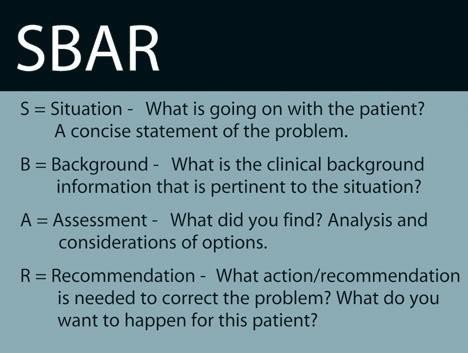A male client who fell at home and experienced a brief loss of consciousness becomes increasingly confused after admission to the medical unit. The family requests an update on the client's condition. Using the SBAR (Situation, Background, Assessment, Recommendation) communication, which information should the nurse provide first?
Increasing confusion of the client.
Client's healthcare power of attorney.
Currently prescribed medications.
Fall at home as reason for admission.
The Correct Answer is A
Choice A Reason: This is the best action because it describes the current situation of the client and alerts the family to a possible change in the client's status. The nurse should provide the most relevant and urgent information first using the SBAR communication.
Choice B Reason: This is not the first action because it does not address the current situation of the client. The nurse should verify the client's healthcare power of attorney, but this is not a priority at this time.
Choice C Reason: This is not the first action because it does not explain the cause of the client's confusion. The nurse should review the client's medications and assess for any adverse effects, but this is not a priority at this time.
Choice D Reason: This is not the first action because it provides background information that is not directly related to the current situation of the client. The nurse should give a brief history of the client's admission, but this can be done later.

Nursing Test Bank
Naxlex Comprehensive Predictor Exams
Related Questions
Correct Answer is D
Explanation
Choice A Reason: This is not the first action because it does not address the safety risk of smoking in the hospital. The nurse should document the occurrence after taking appropriate measures to prevent fire and injury.
Choice B Reason: This is not the first action because it does not stop the client from smoking in the bathroom. The nurse should obtain a prescription for a nicotine patch if the client agrees to quit smoking, but this is not a priority at this time.
Choice C Reason: This is not the first action because it does not ensure that the client will comply with the hospital smoking policy. The nurse should educate the client about the health hazards of smoking and the hospital rules, but this can be done later.
Choice D Reason: This is the best action because it alerts the authority figure who can intervene and enforce the hospital smoking policy. The nurse should notify the charge nurse as soon as possible to prevent fire and injury.
Correct Answer is D
Explanation
Choice A Reason: This is not the best action because it does not address the conflict between the client and the healthcare provider. The nurse should advocate for the client's wishes and seek a resolution that respects them.
Choice B Reason: This is not an appropriate action because it disregards the client's request and may give false hope. The nurse should respect the client's autonomy and dignity.
Choice C Reason: This is not a sufficient action because it does not ensure that the healthcare provider will comply with the client's request. The nurse should also involve other resources to help resolve the ethical dilemma.
Choice D Reason: This is the best action because it involves an impartial group of experts who can help mediate the situation and protect the client's rights. The nurse should seek ethical consultation when there is a disagreement about end-of-life decisions.
Whether you are a student looking to ace your exams or a practicing nurse seeking to enhance your expertise , our nursing education contents will empower you with the confidence and competence to make a difference in the lives of patients and become a respected leader in the healthcare field.
Visit Naxlex, invest in your future and unlock endless possibilities with our unparalleled nursing education contents today
Report Wrong Answer on the Current Question
Do you disagree with the answer? If yes, what is your expected answer? Explain.
Kindly be descriptive with the issue you are facing.
